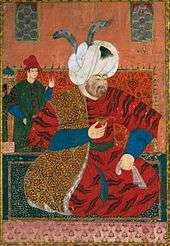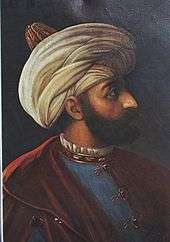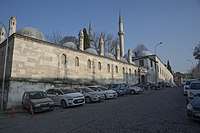Nurbanu Sultan
Nurbanu Sultan (Ottoman Turkish: نور بانو سلطان; c. 1525[1] – 7 December 1583) was Haseki Sultan of the Ottoman Empire as the principal consort of Sultan Selim II (reign 1566–1574), his legal wife, as well as Valide Sultan as the mother of Sultan Murad III (reign 1574–1595). She was one of the most prominent figures during the time of the Sultanate of Women. Conflicting theories ascribe her a Venetian, Jewish[2] or Greek[3] origin. Her birth name may have been Cecilia Venier-Baffo,[4] Rachel[5] or Kalē Kartanou.[6]
| Nurbanu Sultan | |||||
|---|---|---|---|---|---|
The türbe of Nurbanu located next to that of Selim II in the courtyard of Hagia Sophia | |||||
| Valide Sultan of the Ottoman Empire | |||||
| Tenure | 15 December 1574 – 7 December 1583 | ||||
| Predecessor | Hafsa Sultan | ||||
| Successor | Safiye Sultan | ||||
| Haseki Sultan of the Ottoman Empire (Imperial Consort) | |||||
| Tenure | 7 September 1566 – 15 December 1574 | ||||
| Predecessor | Hurrem Sultan | ||||
| Successor | Safiye Sultan | ||||
| Born | Cecilia Venier-Baffo or Rachel or Kalē Kartanou c. 1525 Paros, Cyclades Islands, Republic of Venice? | ||||
| Died | 7 December 1583 (aged 57–58) Bahçi Palace, Istanbul, Ottoman Empire | ||||
| Burial | Hagia Sophia Mosque, Istanbul | ||||
| Spouse | Selim II | ||||
| Issue | |||||
| |||||
| Religion | Islam, previously Roman Catholic or Jewish or Greek Orthodox | ||||
Theories about her origin
There are several theories about the ethnic roots of Nurbanu, none of which is generally accepted:
Jewish origin
Turkish historian Ahmet Refik believed she was of Jewish descent,[7] followed by some Turkish historians.[1]
Cecilia Venier-Baffo
In 1900, Emilio Spagni claimed that she was a Venetian patrician, daughter of Nicolò Venier and Violanta Baffo, abducted on Paros when it was captured by Ottoman admiral Hayreddin Barbarossa in the Third Ottoman-Venetian War. The Sultana, herself, would often say she was of Venetian patrician descent, but never named her family.[6]
Kalē Kartanou
In 1992, B. Arbel challenged the view that she was really of Venetian descent. For him, the most plausible theory is that she was a Greek from Corfou named Kale Kartanou.[6]
Early life
Nurbanu Sultan was born in 1525, she was the daughter of Nicoló Venier. In 1537, she was captured by Hayreddin Barbarossa, during the Venetian expedition, she was captured and was taken to Ottoman Empire. [8]
Nurbanu who was said to be prominent in the palace with her beauty and extraordinary intelligence, was send to Konya as on of the girls of the harem of Şehzade Selim in 1543, in 1544 she gave birth to her first child, a daughter Şah Sultan, in 1545 she gave birth to her second child Ismihan Sultan and on 4 July 1546 she gave birth to her third child, her only son Şehzade Murad who would later become the Sultan of the Empire. [8]
Haseki Sultan

Nurbanu became the most favored consort of Şehzade Selim (who became Ottoman Sultan as Selim II in 1566), and the mother of Şehzade Murad (the future Murad III, born 1546).
While her spouse Selim was still a şehzade, Nurbanu had been the head of his princely harem at Manisa.
Once he became sultan, Selim let his favorite wife, the haseki Nurbanu, remain at the Topkapı Palace throughout his reign, as his predecessor (Suleiman the Magnificent) had done.[9]
Even after Selim began to take other concubines, Nurbanu persisted as a favorite for her beauty and intelligence. As the mother of the heir-apparent, she acted as an advisor to her husband. Although it was far from normal at the time, Selim II would often ask Nurbanu for her advice on various subjects because of his respect for her good judgment. The Venetian ambassador Jacopo Soranzor reported:
"The Haseki is said to be extremely well-loved and honored by His Majesty both for her great beauty and for being unusually intelligent."[10]
She became a formidable figure with far-reaching influence during this time. According to some sources (mostly Venetian accounts), her influence was such that Nurbanu Sultan effectively ran the government alongside the Grand Vizier Sokollu Mehmed Pasha. The Ottoman Empire was far from stable at the top, and clashes over the imperial throne were common. It was also not unusual for the loser in such contests to have his entire family massacred along with him to prevent any future challenges. Nurbanu Sultan was determined, however, that when the time came for her son to succeed his father, nothing would interfere with that.
When Selim II's reign ended in 1574, the haseki Nurbanu received 1,100 aspers a day, while Selim's other consorts, each the mother of a son, received only 40 aspers.[11][12]
Valide Sultan

Şehzade Murad had been sent to serve as Governor of Manisa on the Aegean coast and was there when Sultan Selim II died in 1574.[13] This would have been the perfect opportunity for someone to seize power with the Sultan dead and his son away from the capital. Nurbanu realized this as much, if not more, than anyone and took quick action. Security and privacy in the harem were the most strict anywhere and no one knew when Selim II had actually died. Nurbanu told no one and hid the dead body of her husband in an icebox and sent to Manisa for her son to come to Constantinople immediately. All the while no one was the wiser that Sultan Selim II had departed this life. It was not made known publicly until twelve days later when Murad arrived and Nurbanu delivered up the body of her late husband. Her son became Sultan Murad III and Nurbanu became Valide Sultan, the highest position a woman could hold in the Ottoman Empire. Unlike her predecessor Hürrem Sultan, Nurbanu outlived her husband and enjoyed absolute power between 1574 and 1583, although she was apparently not resident in the Palace after Selim II's death.
Under the influence of Nurbanu on the harem, her son Murad's great respect for her also played a role. In this way, the Sultanate became a high status and became an important and powerful position of the dynasty. Nurbanu's pocket money, which reaches high amounts among both dynastic members and high level officials, is considered as an indicator of this power. As valide sultan she was allocated 2000 coins daily.[8]
Nurbanu had the ultimate power, and she became a formidable figure with far-reaching influence. Canfeda Hatun, Raziye Hatun, and Hubbi Hatun ladies-in-waiting to Murad and Nurbanu also appear to have been very powerful and influential during his reign.[14][15]
Nurbanu Sultan became famous in her old age with her relations with her son's wife Safiye Sultan. As Safiye Sultan said, "I saw Nurbanu for the first time in her mid-forties, but despite her advanced age, she was the most beautiful woman I have ever seen." [16]
Foreign politics
After Nurbanu became the valide sultan to her son Murad III, she effectively managed the government together with the Grand Vizier Sokollu Mehmed Pasha, who acted as co-regent with the sultan during the Sultanate of Women.
Her intermediary to the world outside the harem was her "Kira", Esther Handali. She corresponded with the queen Catherine de' Medici of France.
It is understood that Nurbanu Sultan used Kira Ester Handali of Jewish origin for his own personal affairs and had a financial relationship with Duke of Naxos Joseph Nassi. Perhaps, due to this network of relationships, the rumor has spread that he was of Jewish origin. Among her close men are Bâbüssaâde Ağası Gazanfer Ağa, the priest Şemsi Pasha, the strong figures of the harem that has been with him since Manisa, Canfeda Hatun and Raziye Hatun.[8] Extensive information is available in the envoy reports about Nurbânû Sultan's close political diplomatic contact with the Venetians. In 1583, the Venice senate agreed to send him a gift worth 2000 Venetian gold for its useful services. According to another report, he prevented the possible Ottoman attack on Crete and warned Captain Ali Pasha about not opening a war on Venice. [8]
Venetian accounts are the most prolific in describing Nurbanu Sultan as a woman who never forgot her Venetian origins. Reportedly, she kept in contact with Venice through her lady-in-waiting Chirana, who kept in regular contact with the Council of Ten in Venice, from whom she (Chirana) received an allowance as a Venetian Agent.[17]
During her nine years of regency (1574–1583), her politics were so pro-Venetian that she was hated by the Republic of Genoa. Some have even suggested that she was poisoned by a Genoese agent. In any case, she died at the palace in the Yenikapı Quarter, Istanbul on 7 December 1583.
Patroness of architecture

This mosque complex was constructed by Mimar Sinan on a vast area. The component buildings in the complex were established on a number of successive and stepped flat levels. Buildings were constructed as the mosque, medresse, school, and the dervish lodge on two separate plains. To the west of these, on a lower flat level were erected the complex of buildings designed to meet social functions such as charity. The public bath is in the south. [18]
The Darüşşifa (hospital), which constitutes the major concern of the present study, is an integral part of the mosque complex constructed by Mimar Sinan, the great Ottoman architect, under the auspices of Nurbanu Sultan between 1570 and 1579. The landed properties that Nurbanu Sultan devoted to the darüşşifa in her mosque complex are scattered over many corners of Istanbul, Rumelia, and Anatolia. Through the revenues remitted from these resources the treatments and needs of patients admitted to the darüşşifa were sponsored. A section specialized in the administration of revenues was also included in the darüşşifa premises. [19]
During her nine years of regency, Nurbanu ordered the renowned Ottoman architect Mimar Sinan to build the Atik Valide Mosque and its surrounding külliye at the district of Üsküdar in Istanbul, where previously a "Jewish bath" was located. The construction of the külliye was completed and put in commission at the end of 1583, just before the demise of Nurbanu on 7 December 1583.
The Atik Valide Complex comprises a mosque, medrese, primary school, convent for mystics, schools for Qur’an recitation and hadith scholars, soup kitchen, hospital, and bathhouse. Mimar Sinan conceived of his major mosques as finely tuned instruments meant to sound the Qur’an as a text-as-event, in a reenactment of the original revelation. He even integrated sounding vessels in the domes to ensure a beautiful performance of the holy text. Based on the endowment deed (vakfiye), one can reconstruct the soundscape Nurbanu created through her patronage. [20]
Nurbanu Sultan has also constructed imaret and bathhouse, which she built in Mercan, Alemdağ and Langa, in Istanbul, she was the first Ottoman women to built a library in this complex. The stone needed during the construction of this mosque and complex was obtained from places close to Istanbul such as Iznik and Gallipoli, wooden Sapanca and Iznik. [8]
She was buried at the mausoleum of her husband Selim II located inside the Hagia Sophia (then a mosque) at Sultanahmet in Istanbul, Turkey.
Death

Nurbanu died at Istanbul on 7 December 1583, during the reign of her son Murad III.[21] She was buried next to Selim II in his mausoleum in the courtyard of Hagia Sophia, thus becoming the first wife of a Sultan to receive the honor of being laid to rest next to her spouse.[22]
Nurbanu Sultan attracted great respect not only during her life but also after her death. As against the norm that sultans remained in the palace during the funeral procession, Murad III accompanied his mother’s corpse, both walking and crying, up to the Fatih mosque where her burial service was to be read. The farthest sultanic mosque from the imperial palace, i.e., the Fatih Mosque, was assigned for the funeral rite. This choice not only enabled as many people as possible to give their blessing to the soul of Nurbanu Sultan but also maintained the extensive appreciation of this religious respect paid to her by the residents of the imperial capital. [18]
Preceding Nurbanu's death, the Venetian ambassador in the Ottoman palace, Paolo Contarini had stated All goods and evils are coming from the mother queen. [18] When Nurbanu died in December 1583, the successor of Contarini reported the following:
"The death of this woman upset some according to their vested interests while contented others. The great authority she enjoyed with her son had gained many people important profits, while on the contrary had eliminated the hopes of some for realizing their wishes. Nevertheless, everybody admits in general that she was an excessively good, courageous and erudite woman"[18]
Issue
With Selim, Nurbanu is confirmed to have had at least four children, including:
- Şah Sultan (1544, Manisa Palace, Manisa – 3 November 1577, Istanbul, buried in Zal Mahmud Paşa Mausoleum, Eyüp), married firstly in 1562 to Damat Hasan Agha, married secondly to Damat Zal Mahmud Pasha.[23]
- Ismihan Sultan (1545, Manisa Palace, Manisa – 8 August 1585, Istanbul, buried in Selim II Mausoleum, Hagia Sophia Mosque), married firstly in 1562 to Damat Sokollu Mehmed Pasha, married secondly in 1584 to Damat Kalaylıkoz Ali Pasha.[23]
- Murad III (4 July 1546, Manisa Palace, Manisa – 16 January 1595, Topkapı Palace, Istanbul, buried in Murad III Mausoleum, Hagia Sophia)
Though the claim remains disputed,[24] several sources also mention her as the mother of:
- Gevherhan Sultan (1544, Manisa Palace, Manisa – Istanbul, buried in Selim II Mausoleum, Hagia Sophia Mosque), married firstly in 1562 to Damat Piyale Pasha, married secondly to Damat Cerrah Mehmed Pasha.[23] (According to a conjecture by Baki Tezcan)
- Fatma Sultan (1559, Konya Palace, Konya – October 1580, Istanbul, buried in Selim II Mausoleum, Hagia Sophia Mosque), married in 1574 to Damat Kanijeli Siyavuş Pasha.[25][26]
In popular culture
She was portrayed by Turkish actress Merve Boluğur in television series Muhteşem Yüzyıl.[27]
See also
- Ottoman dynasty
- Ottoman family tree
- List of Valide Sultans
- List of consorts of the Ottoman Sultans
References
Notes
- A.H. de Groot, s.v. in Encyclopaedia of Islam vol.8 p.124
- Stanford J. Shaw, History of the Ottoman Empire and modern Turkey, Volume 1, p. 178, at Google Books
- Arbel, Benjamin, Nur Banu (c. 1530-1583): A Venetian Sultana?
- Godfrey Goodwin, The Private World of Ottoman Women, Saqi Book, ISBN 0-86356-745-2, ISBN 3-631-36808-9, 2001. page 128,
- Valeria Heuberger, Geneviève Humbert, Geneviève Humbert-Knitel, Elisabeth Vyslonzil, Cultures in Colors, page 68. ISBN 3-631-36808-9, 2001
- Arbel, Benjamin, Nur Banu (c. 1530-1583): A Venetian Sultana?, Turcica, 24 (1992), pp. 241-259.
- Çağatay Uluçay, Padişahların Kadınları ve Kızları p.68, citing Kadınlar Saltanatı I p.95
- "NURBÂNÛ SULTAN (ö. 991/1583) III. Murad'ın annesi, vâlide sultan". İslam Ansiklopedisi. Retrieved 3 February 2020.
- Peirce 1993, p. 121.
- Peirce 1993, p. 228.
- Peirce 1993, p. 108.
- Peirce 1993, p. 129.
- Peirce, Leslie P. (1993). The Imperial Harem: Women and Sovereignty in the Ottoman Empire. Oxford University Press. ISBN 9780195086775.
- Maria Pia Pedani Fabris, Alessio Bombaci (2010). Inventory of the Lettere E Scritture Turchesche in the Venetian State Archives. BRILL. p. 26. ISBN 978-9-004-17918-9.
- Petruccioli, Attilio (1997). Gardens in the Time of the Great Muslim Empires: Theory and Design. E. J. Brill. p. 50. ISBN 978-9-004-10723-6.
- "Nurbanu Sultan Haseki Sultan, Hayırsever, Valide Sultan". www.biyografia.com. Retrieved 23 June 2020.
- Ioanna Iordanou, Venice's Secret Service: Organizing Intelligence in the Renaissance
- Düzbakar 2006, p. 14.
- Düzbakar 2006, p. 15.
- Ergin 2014, p. 100.
- "Death in the Topkapı Harem - TASTE OF THE PAST". Hürriyet Daily News | LEADING NEWS SOURCE FOR TURKEY AND THE REGION. Retrieved 2017-10-21.
- Peirce, Leslie P. (1993). The Imperial Harem: Women and Sovereignty in the Ottoman Empire. Oxford University Press. ISBN 9780195086775.
- Tezcan, Baki (2001). Searching For Osman: A Reassessment Of The Deposition Of Ottoman Sultan Osman II (1618-1622). unpublished Ph.D. thesis. pp. 327 n. 16.
- Peirce, p. 92.
- Uluçay 1985, p. 43.
- Freely 1999.
- "Merve Boluğur kimdir? Nurbanu Sultan nasıl öldü?". turkiyegazetesi.com.tr (in Turkish). Retrieved 2017-10-21.
Bibliography
- Arbel, Benjamin, Nur Banu (c. 1530-1583): A Venetian Sultana?, Turcica, 24 (1992), pp. 241–259.
- Peirce, Leslie Penn (1993). The Imperial Harem: Women and Sovereignty in the Ottoman Empire. Studies in Middle Eastern History. New York: Oxford University Press. ISBN 978-0-19-507673-8.CS1 maint: ref=harv (link)
- A.D. Alderson, The Structure of the Ottoman Dynasty. Clarendon Press, Oxford, 1956.
- Almanach de Gotha: annuaire généalogique, diplomatique et statistique, Justes Perthes, Gotha, 1880–1944.
- Dr. Ömer Düzbakar, Charitable Women And Their Pious Foundations In The Ottoman Empire: The Hospital of The Senior Mother, Nurbanu Valide Sultan, 2006
- Burke's Royal Families of the World, Volume II: Africa & The Middle East, Burke's Peerage Ltd., London, 1980.
- A.H. de Groot, s.v. in Encyclopaedia of Islam vol.8 p. 124
- Yılmaz Öztuna, Devletler ve Hanedanlar, Turkiye 1074-1990, Ankara, 1989.
- Osman Selâheddin Osmanoğlu, Osmanli Devleti'nin Kuruluşunun 700. Yılında Osmanlı Hanedanı, Islâm Tarih, Sanat ve Kültür Araştırma Vakfı (ISAR), Istanbul, 1999.
- Emine Fuat Tugay, Three Centuries: Family Chronicles of Turkey and Egypt, Oxford, 1963.
- Uluçay, Mustafa Çağatay (1985). Padışahların kadınları ve kızları. Türk Tarihi Kurumu Yayınları.
- Freely, John (1999). Inside the Seraglio: Private Lives of the Sultans in Istanbul. Viking. ISBN 978-0140270563.
External links
| Ottoman royalty | ||
|---|---|---|
| Preceded by Hürrem Sultan |
Haseki Sultan 7 September 1566 – 15 December 1574 |
Succeeded by Safiye Sultan |
| Preceded by Hafsa Sultan |
Valide Sultan 15 December 1574 – 7 December 1583 | |
